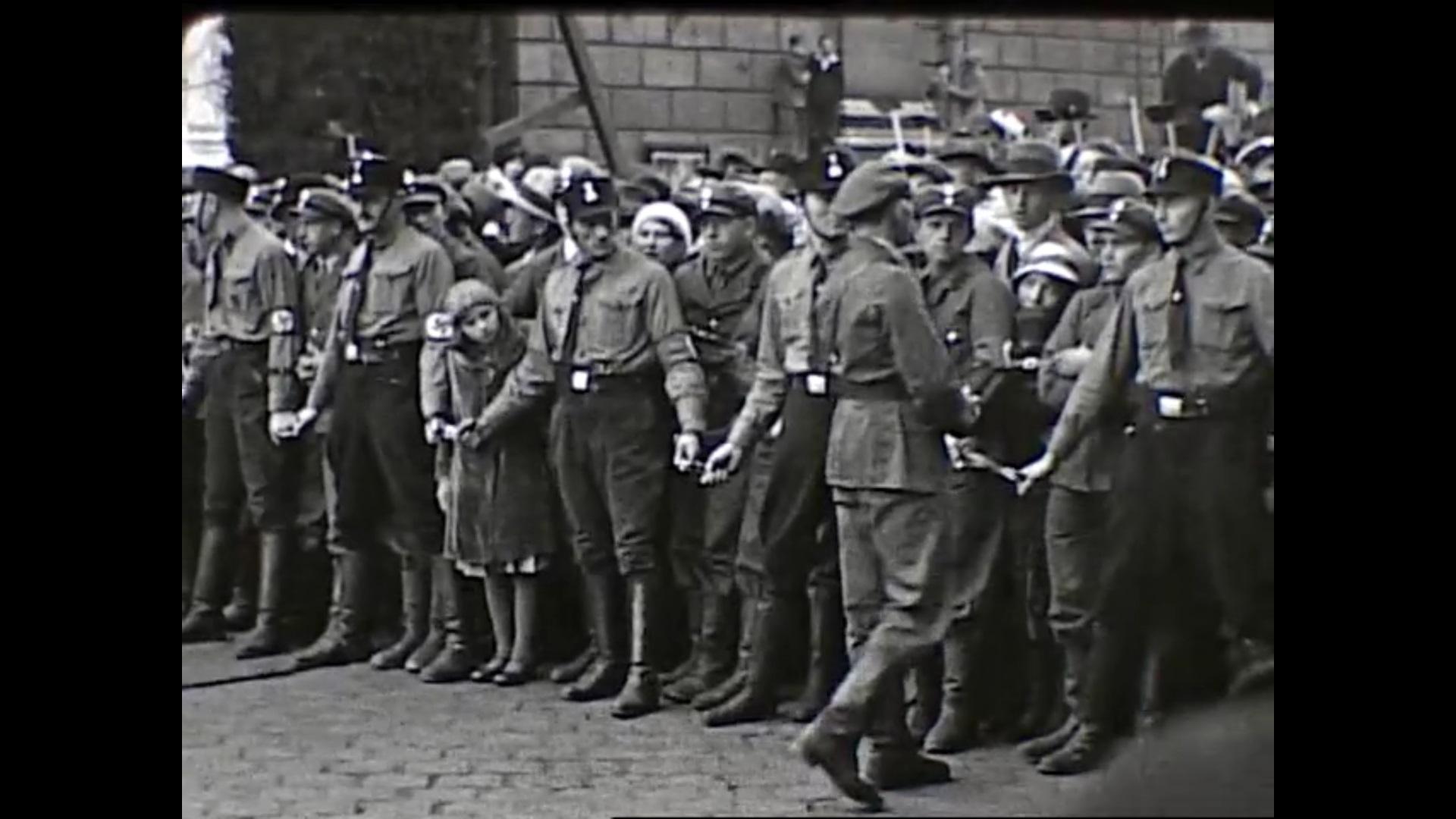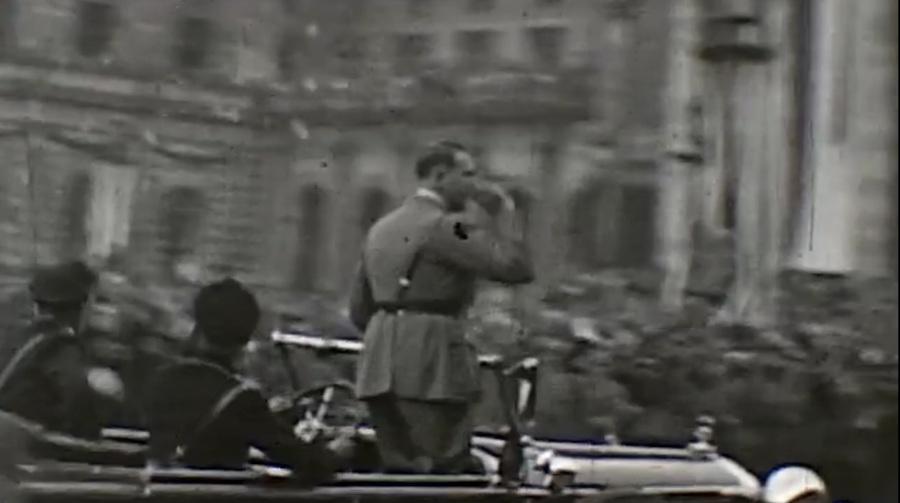In which Adolf Hitler creeps into your home movies
A still frame from a film shot by American doctor Ralph H. Major showing Adolf Hitler at a Nazi event in 1933 or 1934.
Ann Major recently decided to digitize her grandfather’s movies. That’s when she found a little surprise.
One of the films happens to include footage of Adolf Hitler at a military parade. Her grandfather Ralph H. Major was an American doctor teaching medicine in Munich in the 1930s, when he captured the scene.
“People were watching the parade. There wasn’t a lot of saluting him or applause,” says Ann Major, a history department administrator at the University of California, Los Angeles. “Seeing the film was eerie.”
That military parade, from 1933 or 1934, isn’t the only German footage the UCLA employee says was sitting “in various garages” for about 50 years. Her grandpa also filmed a dog parade, a church procession, a parade in honor of German art, and a parade with lots of people wearing medieval costumes.
“I knew some of the footage was from the 1930s, but I wasn’t aware [Hitler was in the film],” she says. “I was 16 when [my grandfather] passed away. My father must have seen the films, but we never saw them when I was growing up.”

More than 70 years after he killed himself, Hitler is still unexpectedly popping up in people’s family movie collections. They may be a bit of a shock, but previously unseen images of the most famous dictator of the 20th century are rare. Finding them could help round out our historical memory.
In Quebec, Rene van der Aa says he also recently digitized his father’s black and white silent films from the 1930s, and what do you know — there was a clip of the Nazi fuhrer, at the Olympics.
You can see Hitler going by in a car, van der Aa says. The Quebecer explains that his father, Hans van der Aa, bought a ticket to the 1936 Berlin Games.
Hans van der Aa was a photographer from the Netherlands, who also filmed Roma communities in Eastern Europe before World War II, as well as his travels through Albania, Italy, Switzerland and North Africa in the 1930s.
Unfortunately, Rene van der Aa lost some of the movies, including the footage of Hitler and the Roma. He thinks they must be somewhere inside his home.
“I have looked everywhere and so far no luck. But it is a big house, with lots of nooks and crannies, and it is not the first time that things turn up later on,” he wrote in an email.
Hans van der Aa passed away 20 years ago.
He was imprisoned in a Nazi camp for hiding a British pilot who had been shot down. After the war, he immigrated to Canada.
Experts say that never-before-seen clips of Hitler are extremely valuable.
“New footage of Hitler is a very rare thing indeed,” says Ed Carter, a documentary curator at the Academy of Motion Picture Arts and Sciences in Los Angeles.
Leslie Swift, who heads a historical media archive at the US Holocaust Memorial Museum in Washington, says amateur films of the Nazi era add to our understanding of history.
“There is a big difference between amateur versus professional film. It’s a much different standpoint from which to film the history,” she says.
She adds that prewar footage of the Roma is very interesting as well. The Roma communities in Europe, sometimes also referred to as Gypsies, were decimated by the Nazis. While there are some films of them in Europe from before the war, these were the work of anthropologists who were documenting the racial characteristics of the Roma, says Swift.
Films of Hitler could also be “worth an enormous amount” as stock footage for people who make documentaries, says Betsy McLane, an American documentary film historian.
None of the people interviewed wanted to estimate the value of the rare films. But to give you an idea, the agency Getty Images charges sometimes thousands of dollars for clips of the Nazi dictator, which were professionally shot but have also been widely viewed.
Yet Van der Aa and Major both say it is not Hitler that they find most fascinating in the films they discovered — but seeing what the world was like in the 1930s. Indeed, you might be surprised to find that people in Italy still filled their water buckets out of public fountains, children ran around barefoot and unsupervised, and horse carriages shared the road with cars. It’s also striking to see how happy the people appear, how unaware they are that a destructive war is about to drown Europe.
When van der Aa was informed of the potential worth of his father’s films, he reacted with disappointment.
“You are breaking my heart,” he wrote in an email. “It’s not the money, but adding to history that is important here.”
1930s home movie boom
The 1930s was a peak time for home-movie making, says Snowden Becker, a film buff who helped Major digitize her grandfather’s reels from Germany.
Becker is a huge fan of home videos: She launched Home Movie Day in 2003. Now the event aims to give people around the world a chance to screen their family films to the public. The next one is this Saturday, October 15.
So, what changed in the '30s? Becker says the hobby became more affordable when 8 mm film was introduced in 1935. With that format, you could get twice the film for half the cost, she says.
“The transition to 8 mm film really made it more of a middle-class hobby,” she says. “There is probably a lot more out there waiting to be found.”
The story you just read is not locked behind a paywall because listeners and readers like you generously support our nonprofit newsroom. If you’ve been thinking about making a donation, this is the best time to do it. Your support will get our fundraiser off to a solid start and help keep our newsroom on strong footing. If you believe in our work, will you give today? We need your help now more than ever!
